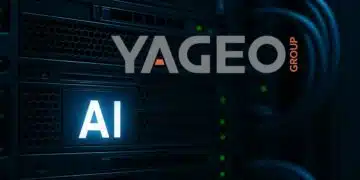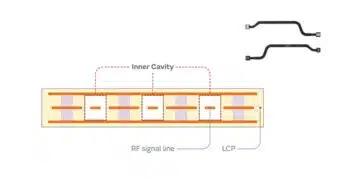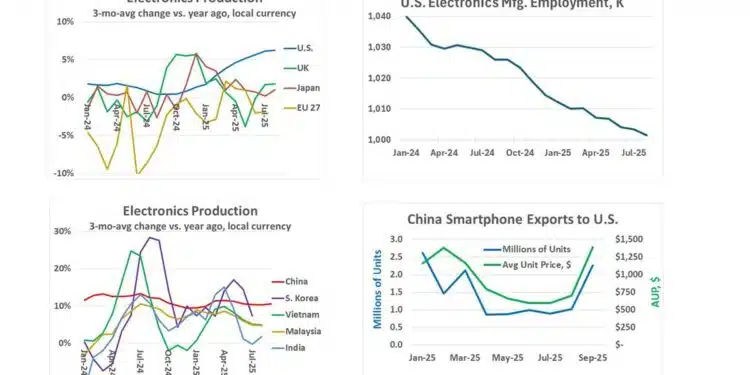U.S. electronics production has grown significantly, driven by a shift in manufacturing from other countries, particularly due to tariff policies according to Semiconductor Intelligence report.
However, this growth hasn’t translated into increased employment, with the sector experiencing a slight decline in jobs. While China’s electronics production remains steady, other Asian countries like South Korea and Vietnam have seen a moderation in growth add the Semiconductor Intelligence report.
KeyPoints
- U.S. Electronics Production Growth: U.S. electronics production has been growing rapidly, with a 3/12 change increasing from 0.4% in October 2024 to 6.2% in August 2025.
- Global Electronics Production Trends: Japan’s production has been growing but decelerating, while the EU has mostly experienced negative growth, and the UK has seen positive growth.
- U.S. Electronics Manufacturing Employment: Despite the growth in production, U.S. employment in electronics manufacturing has declined slightly from January 2024 to August 2025.
- China’s Electronics Production: Steady growth with a 3/12 change ranging from 10% to 13% since January 2024.
- South Korea’s Electronics Production: 3/12 change moderated to 7.4% in July 2025 from 17% in May.
- India’s Electronics Production: Volatile 3/12 change, peaking at 15% in April 2025 and dropping to zero in July.
- Smartphone Imports Trend: U.S. smartphone imports declined significantly from April 2025, likely due to anticipated tariffs.
- China’s Smartphone Export to U.S.: China’s smartphone exports to the U.S. surged in September 2025, coinciding with the release of Apple’s iPhone 17 models.
- Tariff Policy Impact: While the tariff policy may have increased U.S. electronics production, it hasn’t led to job creation in the industry.
U.S. electronics production has been experiencing a rapid growth trend over the past ten months. The three-month average change compared to the same period last year (3/12 change) has increased significantly, rising from 0.4% in October 2024 to 6.2% in August 2025. Japan’s 3/12 change has been positive since November 2024 but has been decelerating throughout 2025, reaching 1.1% in August. The European Union (EU 27) comprises 27 countries, and most of them have mostly experienced negative 3/12 changes, with July 2025 recording a -1.8% change. In contrast, the United Kingdom (UK) saw a positive 3/12 change in July and reached 1.8% in August.
The accelerating growth in U.S. electronics production can be partially attributed to the shift of manufacturing from other countries to the United States by both U.S. and foreign companies. This shift is primarily driven by the Trump administration’s tariffs, both implemented and threatened. However, this manufacturing shift has not resulted in increased employment in the electronics manufacturing sector. According to the U.S. Bureau of Labor Statistics, U.S. employment in electronics manufacturing has declined from 1.04 million jobs in January 2024 to 1.001 million jobs in August 2025. August is the latest available month due to the government shutdown. Over the past decade, employment in this sector has remained relatively stable, fluctuating between 1.001 million and 1.062 million jobs.
Electronics production in key Asian countries has been volatile but generally growing over the past two years. The shift of electronics manufacturing to the U.S. has not significantly impacted China. China’s electronics production has shown steady growth, with a 3/12 change ranging from 10% to 13% since January 2024. In September 2025, China’s 3/12 change was 10.7%. South Korea’s 3/12 change moderated to 7.4% in July 2025 from 17% in May. Malaysia and Vietnam experienced similar trends in the last six months, with their 3/12 change moderating from the 8% to 10% range in March through May 2025 to the 5% to 6% range in June through August. India’s electronics production has been volatile, with a 3/12 change peaking at 15% in April 2025 and dropping to zero in July. India’s 3/12 change in August was 1.9%.
As mentioned in our June 2025 newsletter, U.S. imports of smartphones have significantly declined starting in April 2025. In April 2025, the Trump administration announced that smartphones were currently exempt from tariffs but would be subject to tariffs within a month or two. However, six months later, no smartphone tariffs have been announced. Imports remained low based on the latest data available through July. Due to the U.S. government shutdown, data for August is not available. Nevertheless, China’s export data is available through September 2025. Apparently, China has a functioning government. In September, China’s exports of smartphones to the U.S. surged sharply to 2.26 million units from 1.02 million units in August, marking a remarkable 121% increase. The average unit price (AUP) of these smartphones almost doubled from $702 in August to $1,387 in September. These increases coincide with Apple’s introduction of its iPhone 17 models in September 2025. Apple and other smartphone companies have apparently been limiting imports to the U.S. due to the tariff threat. However, they increased imports in September to support the release of new models.
While the Trump administration’s tariff policy may have contributed to increased U.S. electronics production, it has not resulted in new job creation in the industry. The ongoing tariffs and potential tariffs continue to create uncertainty in the U.S. and global electronics industry.
































